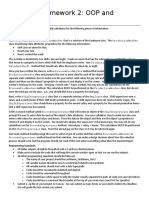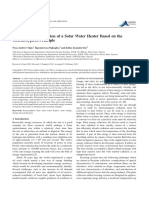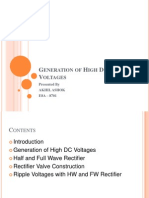0 ratings0% found this document useful (0 votes)
418 viewsCapstone Micro Turbine & ORC
Capstone Micro Turbine & ORC
Uploaded by
andy131078The document describes an Organic Rankine Cycle (ORC) waste heat recovery system. It works by using a lower boiling point fluid to capture low-temperature waste heat and convert it to electricity. The fluid is vaporized using waste heat and the vapor drives a turbine connected to a generator before condensing back to liquid. This allows electricity production from heat sources above 85°C. The system improves overall efficiency by utilizing heat that would otherwise go to waste.
Copyright:
© All Rights Reserved
Available Formats
Download as PDF, TXT or read online from Scribd
Capstone Micro Turbine & ORC
Capstone Micro Turbine & ORC
Uploaded by
andy1310780 ratings0% found this document useful (0 votes)
418 views32 pagesThe document describes an Organic Rankine Cycle (ORC) waste heat recovery system. It works by using a lower boiling point fluid to capture low-temperature waste heat and convert it to electricity. The fluid is vaporized using waste heat and the vapor drives a turbine connected to a generator before condensing back to liquid. This allows electricity production from heat sources above 85°C. The system improves overall efficiency by utilizing heat that would otherwise go to waste.
Original Description:
c
Copyright
© © All Rights Reserved
Available Formats
PDF, TXT or read online from Scribd
Share this document
Did you find this document useful?
Is this content inappropriate?
The document describes an Organic Rankine Cycle (ORC) waste heat recovery system. It works by using a lower boiling point fluid to capture low-temperature waste heat and convert it to electricity. The fluid is vaporized using waste heat and the vapor drives a turbine connected to a generator before condensing back to liquid. This allows electricity production from heat sources above 85°C. The system improves overall efficiency by utilizing heat that would otherwise go to waste.
Copyright:
© All Rights Reserved
Available Formats
Download as PDF, TXT or read online from Scribd
Download as pdf or txt
0 ratings0% found this document useful (0 votes)
418 views32 pagesCapstone Micro Turbine & ORC
Capstone Micro Turbine & ORC
Uploaded by
andy131078The document describes an Organic Rankine Cycle (ORC) waste heat recovery system. It works by using a lower boiling point fluid to capture low-temperature waste heat and convert it to electricity. The fluid is vaporized using waste heat and the vapor drives a turbine connected to a generator before condensing back to liquid. This allows electricity production from heat sources above 85°C. The system improves overall efficiency by utilizing heat that would otherwise go to waste.
Copyright:
© All Rights Reserved
Available Formats
Download as PDF, TXT or read online from Scribd
Download as pdf or txt
You are on page 1of 32
At a glance
Powered by AI
The key takeaways are that Organic Rankine Cycle systems can convert low-grade waste heat into electricity using working fluids that have lower boiling points than water. This allows the utilization of heat sources that would otherwise be wasted.
The main components of an Organic Rankine Cycle system are an evaporator, turbine, generator, condenser, pump and a working fluid with a lower boiling point than water such as propane, pentane or R245fa. The working fluid absorbs heat in the evaporator and expands through the turbine to generate electricity.
In an Organic Rankine Cycle system, the working fluid is pumped from the condenser as a liquid to the evaporator where it is heated by the low-grade waste heat source. This causes the working fluid to evaporate which expands through the turbine to generate electricity. The vapor is then condensed back into a liquid in the condenser before repeating the cycle.
Organic Rankine Cycle (ORC)
Waste Heat Generator (WHG)
Technical Information provided
by Greenvironment plc
confidential
1
Waste Heat Generator (WHG)
Converts waste heat into electricity
Capable of using low grade waste heat
Waste Heat Generator (WHG)
2
Turbines
Devices that converts fluid
flow into work
Gas turbine
Working fluid is combustion
products and air
Water turbine (hydro)
Working fluid is water
Steam turbine
Rankine Cycle water is boiled
to vapor before passing through
turbine
Working fluid is water vapor
(steam)
3
Rankine Cycle
Thermodynamic cycle which converts
heat into work
Working fluid is often steam
Requires high temperatures to vaporize water
80% of all power in the world is produced with this
technology
Water
CONDENSER
Low Temperature
heat sources produce
little useable steam
Inherit problem is
high latent heat of
water in liquid-vapor
phase change
4
Organic Rankine Cycle
For many (low temperature) waste heat applications, we
need a fluid that boils at a lower temperature than water
Historically, such fluids have been hydrocarbons - hence
the name Organic
Modern Working Fluids include: Propane / Pentane /
Toluene / HFC-R245fa
These Working Fluids allow use of Lower-Temperature
Heat Sources because the liquid-vapor phase change, or
boiling point, occurs at a lower temperature than the water-
steam phase change
Water R245fa
1 bar (0 psig) 100C (212F) 15,6C (60F)
19,6 bar (270 psig) 212C (413F) 121C (250F)
5
Waste Heat Sources
Waste heat is any source of otherwise unused
heat that is why fuel is free
Waste heat from MicroTurbine exhaust
Waste heat from industrial processes
Process stacks from drying or heating processes
Heat from waste fuel
Biomass or Biogas is burns to produce heat directly
Not waste heat
A boiler creates heat for vaporization in a closed loop
system not free fuel
6
The Complete System
Integrated
Power
Module
Evaporative
Condenser
Evaporator
Heat
Source
375F (190C)
3 MBTU/H
Generate
125 kW
R245fa
Pump
7
How it Works - 1
Integrated
Power
Module
Evaporativ
e Condenser
Receiver
Economizer
Evaporator
Liquid
85F (29C)
230psig
(16bar)
Heat Source
375F (190C)
3 MBTU/H
Generate
125 kW
Liquid
85F (29C)
26psig
(1.8bar)
R245fa
Pump
The working fluid is in the receiver as a liquid at the condensing pressure and temperature. It
enters the pump where the working fluids pressure is raised to the evaporating pressure.
8
How it Works - 2
Evaporative
Condenser
Receiver
Economizer
Evaporator
Heat Source
375F (190C)
3 MBTU/H
Liquid
118F
(48C)
220psig
(15bar)
R245fa
Pump
The working fluid passes through a heat exchanger (Economizer) to take heat out of the gas
leaving the Integrated Power Module. This improves system efficiency. The working fluid is now
a warmer, high pressure liquid.
Integrated
Power
Module
Generate
125 kW
Liquid
85F (29C)
230psig
(16bar)
Liquid
85F (29C)
26psig
(1.8bar)
9
How it Works - 3
9
Evaporative
Condenser
Receiver
Economizer
Evaporator
Vapor
240F
(115C)
220psig
(15bar)
Heat
Source
375F
(190C)
3 MBTU/H
R245fa
Pump
The working fluid enters the Evaporator, where the working fluid is exposed to waste heat which
evaporates the fluid to a high pressure vapor.
Integrated
Power
Module
Generate
125 kW
Liquid
118F
(48C)
220psig
(15bar)
Liquid
85F (29C)
230psig
(16bar)
Liquid
85F (29C)
26psig
(1.8bar)
Integrated
Power
Module
10
How it Works - 4
Evaporative
Condenser
Receiver
Economizer
Evaporator
Heat Source
375F (190C)
3 MBTU/H
Vapor
145F
(63C)
26psig
(1.8bar)
R245fa
Pump
The working fluid (now a vapor) enters the turbine of the IPM. The working fluids pressure drops
across the turbine to the condensing pressure, spinning the turbine (which is connected to the
generator) in the process. The driving force is the pressure difference across the turbine.
Generate
125 kW
Vapor
240F
(115C)
220psig
(15bar)
Liquid
118F
(48C)
220psig
(15bar)
Liquid
85F (29C)
230psig
(16bar)
Liquid
85F (29C)
26psig
(1.8bar)
11
How it Works - 5
1
1
Evaporative
Condenser
Receiver
Economizer
Evaporator
Heat Source
375F (190C)
3 MBTU/H
R245fa
Vapor
85F
(29C)
26psig
(1.8bar)
Pump
The working fluid still has an enormous amount of heat, some of which is transferred to the
pumped liquid in the economizer. This helps in two ways: 1) this heat would have otherwise
been extracted in the condenser and; 2) there is less heat required at the evaporator due to the
liquid being pre-warmed.
Vapor
145F
(63C)
26psig
(1.8bar)
Vapor
240F
(115C)
220psig
(15bar)
Liquid
118F
(48C)
220psig
(15bar)
Liquid
85F (29C)
230psig
(16bar)
Liquid
85F (29C)
26psig
(1.8bar)
12
How it Works - 6
Evaporative
Condenser
Receiver
Economizer
Evaporator
Heat
Source
375F
(190C)
3 MBTU/H
Ambient
Air 75F
(24C)
Wet Bulb
R245fa
Vapor
85F (29C)
26psig
(1.8bar)
Pump
The working fluid (still a vapor) then flows to the condenser where heat is extracted and the
working fluid condenses to a liquid.
Vapor
85F
(29C)
26psig
(1.8bar)
Vapor
145F
(63C)
26psig
(1.8bar)
Vapor
240F
(115C)
220psig
(15bar)
Liquid
118F
(48C)
220psig
(15bar)
Liquid
85F (29C)
230psig
(16bar)
Liquid
85F (29C)
26psig
(1.8bar)
13
How it Works - 7
Evaporative
Condenser
Receiver
Economizer
Evaporator
R245fa
Pump
The low pressure, liquid working fluid drains back to the receiver and is ready to be pumped to
high pressure and flow towards the integrated power module.
Heat Source
375F (190C)
3 MBTU/H
Ambient
Air 75F
(24C)
Wet Bulb
Vapor
85F (29C)
26psig
(1.8bar)
Vapor
85F
(29C)
26psig
(1.8bar)
Vapor
145F
(63C)
26psig
(1.8bar)
Vapor
240F
(115C)
220psig
(15bar)
Liquid
118F
(48C)
220psig
(15bar)
Liquid
85F (29C)
230psig
(16bar)
Liquid
85F (29C)
26psig
(1.8bar)
14
Applications
Turbines Exhaust
Waste heat from exhaust
Industrial Stack Gas
Refineries
Incinerators
Drying processes
15
Applications
Geothermal
Water or Steam
Solar Thermal
After steam process
Indirect evap source
16
The ORC Power Skid
Capstone supplies the ORC Power Skid
Includes electronics, receiver, economizer, power module and
various pumps
Needs external evaporator and condenser
Power Skid Fluid Connections
Warm Liquid to
Evaporator
Cool Liquid from
Condenser
Hot Vapor from
Evaporator
Warm Vapor to
Condenser
18
Power Skid Components
Receiver
Pump
Field
Connections
Integrated
Power
Module
Power
Electronics
Programmable
Logic Controller
(PLC) & Magnetic
Bearing Controller
(MBC)
VFD for Pump
Separator
Inlet Control
Valve
Bypass
Valve Economizer
Separator
Drain Valve
Slam
Valve
19
Power Skid Specs
Turbine Expander and Generator
Hermetically sealed power module no leaks
Magnetic Bearings no lubricants
26,500 rpm no vibration
Power electronics 125 kW
Grid Connect only
380-480V, 3 phase, 3 wire 50/60 Hz
Working fluid HFC-R245fa
Dry weight 7,000 lbs
46 w x 112 l x 79.5 h
20
Evaporator
Transfers waste heat energy to refrigerant,
resulting in vaporization
Direct, heat transfers directly from the waste heat source
to the working fluid
Likely choice for a Microturbine application where waste
temperatures are low and exhaust stream is clean
Heat source needs to be near ORC
Indirect, thermal transfer medium is used between the
heat source and the working fluid (e.g. thermal oil, hot
water, steam)
Requires more ancillary equipment
Less efficient overall
Good fit if heat source is far from ORC
21
Condenser
Rejects latent heat of working fluid, resulting in
condensation
Direct The working fluid passes through a heat
exchanger that rejects heat directly to the environment.
Indirect A medium such as water is passed through a
heat exchanger and takes the rejected heat out of the
working fluid. The medium then transfers the heat
somewhere else.
Cooling towers, air cooled condenser (Dry Cooler),
ground water, evaporative condenser
Cooling towers (if already existing) and direct evaporative
condensers are likely the best match for MicroTurbine
applications
22
Installation Considerations
Evaporator & Condenser must be within 50ft of the
ORC power skid
Minimize refrigerant run length
Minimize heat loss / absorption
Minimize amount of R245fa used
Condenser must be elevated (flow to receiver)
Qualified technician required to handle R245fa
Internal cleanliness (of R245fa loop) important
23
Complete Installation
24
Heating, Cooling, Power
Cycle effectiveness is determined by the
heat source and condensing source
Determine total heat and temperature available
Determine total cooling available
Power available is determined by multiplying
the heat available by the cycle effectiveness
More heat available => less cooling required
Less heat available => more cooling required
25
Available Power Output
More heat is
required for a
given power
production as
condensing
temp increases.
Size heat
source and
condenser for
ambient
conditions.
26
ORC with MicroTurbines
Typical MicroTurbine implementation
6 to 8 Capstone C65 MicroTurbines
One ORC WHG Power Skid
One direct MT exhaust to refrigerant heat
exchanger
One direct evaporative cooling tower or
piggyback on existing cooling tower.
27
Free Electricity?
Or, how to build a ORC WHG value
proposition
System uses low grade heat that is usually
wasted no other good use
Increase overall efficiency of systems
Consumes no additional fuel
Produces no additional emissions
Wasted energy into electric power may
Reduce demand charges
Capture carbon credits
Qualify for renewable energy incentives
28
Calculating New Efficiency
Using waste heat to generate electric power
increases overall system efficiency
Low grade waste heat is used, so assume it can
not be used for any other purpose
Example, 6 Capstone C65s
Produce 390kW at 29% Electric Eff
A 125kW ORC WHG is added
515kW is produced, using no added fuel
new efficiency is
(New power/old power)*old Efficiency = 38%
The ORC increases electric efficiency to over 38%
29
Case Study
Biomass boiler test site in the south east USA.
30
Case Study Payback
Free fuel and low Maintenance Cost provide
payback
Annual Run Hours 8,400
Net Electrical Output 107kWe
Annual Production 8,400 x 107 = 898,800 kWh
Gross Revenue 898,800 x $0.18 = $161,784
Maintenance Cost 898,800 x $0.0075 = $6,741
Net Annual Revenue $155,043
Cost of Project $298,000
Simple Payback < 2 years
31
Technology Advantages
Very similar to those of Capstone MicroTurbines
!"#$ &'(() *(+(,-./, 0+1,(-2() 341"(+156 7(8"-9"8".56 +/ #(-, 9/:
;-#+(<1 =(-,"+#2
0+1,(-2() 341"(+156 7(8"-9"8".56 7()>1()
8/22(2
?/@(, 38(1.,/+"12 341"(+. A-,"-98( 2'(() /'(,-</+
B/ 8>9,"1-</+ /, 8>9,"1-</+ 252.(C
0+1,(-2() 7(8"-9"8".56 7()>1() '-,-2"<1 8/22(26
B/ 1/+.-C"+-</+ /D ',/1(22 E>")
B/ 1/>'8"+# 0+1,(-2() ,(8"-9"8".56 D(@(, 1/C'/+(+.2
F-,"-98( 2'(() /'(,-</+ G'<C"H() 1518( (41"(+15 /'(,-<+# '/"+.
!(,C(<1-885 2(-8() !"#$(, ,(8"-9"8".56 D(@(, @(-, 1/C'/+(+.2
&"+#8( C/A"+# '-,. 0+1,(-2() ,(8"-9"8".5
;/)>8-, I(2"#+
&"C'8( 0+.(#,-</+ "+./ 252.(C J8"K( 2.-+)-,)
'"'"+#L
You might also like
- Calix AXOS R21.3.0 Release Notes For E7-2 and E3-2: PrefaceDocument13 pagesCalix AXOS R21.3.0 Release Notes For E7-2 and E3-2: Prefacerico orense100% (1)
- A Project Report On "Modelling of Fact Device For Power Flow Analysis"Document45 pagesA Project Report On "Modelling of Fact Device For Power Flow Analysis"gopalchandramahatoNo ratings yet
- LCI 750SpecSheetDocument5 pagesLCI 750SpecSheetandy131078100% (1)
- Flare Data SheetDocument3 pagesFlare Data Sheetandy131078No ratings yet
- Mobility Trainguard Full Interoperability For Rail Traffic PDFDocument66 pagesMobility Trainguard Full Interoperability For Rail Traffic PDFRizki Fajar NovantoNo ratings yet
- Case History - MBR Plant Achieves Higher Flow With PermaCareDocument4 pagesCase History - MBR Plant Achieves Higher Flow With PermaCareSandeep K TiwariNo ratings yet
- HW2 - InheritanceDocument2 pagesHW2 - InheritanceRuochen WuNo ratings yet
- Capstone Micro Turbine ORCDocument32 pagesCapstone Micro Turbine ORCpowermanagerNo ratings yet
- Sustainable Energy Conversion for Electricity and Coproducts: Principles, Technologies, and EquipmentFrom EverandSustainable Energy Conversion for Electricity and Coproducts: Principles, Technologies, and EquipmentNo ratings yet
- Organic Rankine CycleDocument6 pagesOrganic Rankine CycleAdrian RajendraNo ratings yet
- Economic Implementation of The Organic Rankine Cycle in Industry PDFDocument11 pagesEconomic Implementation of The Organic Rankine Cycle in Industry PDFKendra TerryNo ratings yet
- Steam Power PlantDocument47 pagesSteam Power PlantOmar HattabNo ratings yet
- Physics EL1234Document37 pagesPhysics EL1234Hydra JagguNo ratings yet
- Electricity Generation Using Solar Powered Stirling Engine: Blessy Joy, Priya John, Anjuman Habeeb, Jeffy Marin JoseDocument5 pagesElectricity Generation Using Solar Powered Stirling Engine: Blessy Joy, Priya John, Anjuman Habeeb, Jeffy Marin JoseIntan Vara DibaNo ratings yet
- Graphene Oxide: Properties & ApplicationsDocument37 pagesGraphene Oxide: Properties & ApplicationsYash MaheshwariNo ratings yet
- Cog en Era Ti OnDocument12 pagesCog en Era Ti OnMayank DubeyNo ratings yet
- UNITIIIDocument48 pagesUNITIIIEla Mathi J100% (1)
- Important Aspects of Desuperheater Design in Power and Process ApplicationsDocument11 pagesImportant Aspects of Desuperheater Design in Power and Process Applications련서긔100% (1)
- Control Air-Fuel RatioDocument19 pagesControl Air-Fuel RatioVaibhav Pratap Singh100% (1)
- ITK-233-6 - Power Production & RefrigerationDocument30 pagesITK-233-6 - Power Production & RefrigerationAndy Noven Krisdianto100% (1)
- Flue Gas Heat Recovery in Power Plants, Part IDocument12 pagesFlue Gas Heat Recovery in Power Plants, Part IknsaravanaNo ratings yet
- 96dpi MTM Produktblatt FT8Document2 pages96dpi MTM Produktblatt FT8blahblah8888100% (1)
- Microcontroller Based High Voltage Pulse Electric Field Generator For PasteurizationDocument3 pagesMicrocontroller Based High Voltage Pulse Electric Field Generator For Pasteurizationijsret0% (1)
- Analysis of Refrigeration System Utilizing Waste Heat On A ShipDocument49 pagesAnalysis of Refrigeration System Utilizing Waste Heat On A ShipEmmanuel KingsNo ratings yet
- Flue Gas Loses PDFDocument91 pagesFlue Gas Loses PDFsaeedalipourNo ratings yet
- ORC DesignDocument38 pagesORC Designmitul78No ratings yet
- Thermosyphon Principle PDFDocument8 pagesThermosyphon Principle PDFManoj KumarNo ratings yet
- High Voltage Pspice Manual PDFDocument35 pagesHigh Voltage Pspice Manual PDFMuhammad Ahtisham AsifNo ratings yet
- Valve ModelingDocument10 pagesValve ModelingmsNo ratings yet
- Self Excitation of Induction MotorsDocument5 pagesSelf Excitation of Induction MotorsDiego Nicolás López-RamírezNo ratings yet
- United States Patent (191: SwensonDocument12 pagesUnited States Patent (191: Swensonkaspersky2009No ratings yet
- Modelling TurbineDocument20 pagesModelling TurbineJeison YarceNo ratings yet
- Thrust Chamber CoolingDocument15 pagesThrust Chamber CoolingSundar MahalingamNo ratings yet
- Control Valve Positioners Instrumentation ToolsDocument8 pagesControl Valve Positioners Instrumentation ToolsFebryn NgkNo ratings yet
- Hap46 ManualDocument160 pagesHap46 ManualFernando100% (1)
- A Technical Reference Manual For Plate Heat Exchangers in Refrigeration & Air Conditioning ApplicationsDocument176 pagesA Technical Reference Manual For Plate Heat Exchangers in Refrigeration & Air Conditioning ApplicationsDanny DanNo ratings yet
- Thermodynamic and Economic Analysis of A Binary Geothermal Power Plant Feasibility Study4Document24 pagesThermodynamic and Economic Analysis of A Binary Geothermal Power Plant Feasibility Study4Angela Paul PeterNo ratings yet
- Chapter No. 1: Catalytic Steam Gasification of MSWDocument79 pagesChapter No. 1: Catalytic Steam Gasification of MSWMUh Ammar100% (1)
- Concepts of ThermodynamicsDocument41 pagesConcepts of ThermodynamicsMichael ElliottNo ratings yet
- Turning Gear For Gas TurbinesDocument4 pagesTurning Gear For Gas TurbinesCharles3iNo ratings yet
- Boiler Steam Cycle AspenPlusv8 PDFDocument35 pagesBoiler Steam Cycle AspenPlusv8 PDFEdgar Enrique Diaz MarquinaNo ratings yet
- Basic Desuperheating TheoryDocument4 pagesBasic Desuperheating TheoryAnonymous CX51waINo ratings yet
- Thermochemical Processing of Biomass: Conversion into Fuels, Chemicals and PowerFrom EverandThermochemical Processing of Biomass: Conversion into Fuels, Chemicals and PowerNo ratings yet
- RPI-TP-0218 Compare Stoker and BFBDocument14 pagesRPI-TP-0218 Compare Stoker and BFBTim Ku100% (1)
- Manual de Transferencia de Datos de AMS Machinery Healt ManagerDocument106 pagesManual de Transferencia de Datos de AMS Machinery Healt ManagerJuan Carlos Rios EsparzaNo ratings yet
- HEAT PIPES Review, Opportunities and ChallengesDocument48 pagesHEAT PIPES Review, Opportunities and ChallengesMarco Antonio CovieloNo ratings yet
- (Elearnica - Ir) - Ground-Source Heat Pumps Systems and ApplicationsDocument28 pages(Elearnica - Ir) - Ground-Source Heat Pumps Systems and ApplicationsSeyed0% (1)
- Sheet No.1 (Carnot-Rankine)Document6 pagesSheet No.1 (Carnot-Rankine)Farah Sayed100% (1)
- Robatherm Medical EngDocument11 pagesRobatherm Medical EngSamiYousifNo ratings yet
- Neration of High DC Voltages - NEWDocument15 pagesNeration of High DC Voltages - NEWMohammed MansoorNo ratings yet
- 4.3 Gas Turbines: 4.3.1 Technology DescriptionDocument11 pages4.3 Gas Turbines: 4.3.1 Technology DescriptionZahid Hussain100% (1)
- Chemical Engineering Dynamics: An Introduction to Modelling and Computer SimulationFrom EverandChemical Engineering Dynamics: An Introduction to Modelling and Computer SimulationNo ratings yet
- Abma Guide 2013-14 WebDocument64 pagesAbma Guide 2013-14 WebAdolfo Perez MonteroNo ratings yet
- Unit 1 Chemistry SASTRA University Water TreatmentDocument6 pagesUnit 1 Chemistry SASTRA University Water Treatmentstar100% (1)
- How To Estimate Compressor Efficiency - Campbell Tip of The MonthDocument8 pagesHow To Estimate Compressor Efficiency - Campbell Tip of The MonthsebatarraNo ratings yet
- Ukhohlwe Izindlela Zokukhiqiza Ugesi Kanye Namandla: Ehlanzekile, Eshibhile, Ngezinye Izikhathi Mahhala Futhi Abe Nekhono Lokushintsha Umhlaba./ LESS KNOWN, CLEAN, LOW COST, ABUNDANT ENERGY TECHNOLOGIES & RELATED GAME CHANGING APPLICATIONS.Document388 pagesUkhohlwe Izindlela Zokukhiqiza Ugesi Kanye Namandla: Ehlanzekile, Eshibhile, Ngezinye Izikhathi Mahhala Futhi Abe Nekhono Lokushintsha Umhlaba./ LESS KNOWN, CLEAN, LOW COST, ABUNDANT ENERGY TECHNOLOGIES & RELATED GAME CHANGING APPLICATIONS.Ben RusuisiakNo ratings yet
- Cyclone FurnaceDocument2 pagesCyclone Furnacecumpio425428No ratings yet
- Kinetics of Fluidized Bed Iron Ore ReductionDocument8 pagesKinetics of Fluidized Bed Iron Ore ReductionMaulana RakhmanNo ratings yet
- Lecture10 StreamTurbines ReactionTurbineDocument7 pagesLecture10 StreamTurbines ReactionTurbineIjazzzAli100% (1)
- Boiler PerformanceDocument20 pagesBoiler Performancesameer betalNo ratings yet
- Challenges in Supercritical CO2 Power Cycle Technology and First OperationalDocument16 pagesChallenges in Supercritical CO2 Power Cycle Technology and First OperationalAdven Brilian100% (1)
- Thermodynamic Properties of Supercritical Carbon Dioxide - Widom and Frenkel LinesDocument5 pagesThermodynamic Properties of Supercritical Carbon Dioxide - Widom and Frenkel LinesDavide Di ZioNo ratings yet
- LCI 550SpecSheetDocument3 pagesLCI 550SpecSheetandy131078No ratings yet
- LCI 1100SpecSheetDocument11 pagesLCI 1100SpecSheetandy131078No ratings yet
- Dave Kalensky (Yanmar - GTI)Document4 pagesDave Kalensky (Yanmar - GTI)andy131078No ratings yet
- High Leverage Spring-Loaded Ball Float Type Drain Traps: Sour Gas ServiceDocument2 pagesHigh Leverage Spring-Loaded Ball Float Type Drain Traps: Sour Gas Serviceandy131078No ratings yet
- D Type Sampling DBB ValveDocument1 pageD Type Sampling DBB Valveandy131078No ratings yet
- Floor Installation GuidelinesDocument52 pagesFloor Installation Guidelinesandy131078No ratings yet
- Spitz Glass EquationDocument3 pagesSpitz Glass Equationandy131078No ratings yet
- Free Floating Lever Dual Gravity Drain TrapsDocument2 pagesFree Floating Lever Dual Gravity Drain Trapsandy131078No ratings yet
- TB27a ENDocument4 pagesTB27a ENandy131078No ratings yet
- Removal of Hydrogen Sulfide From Biogas Using Dry Desulfurization SystemsDocument4 pagesRemoval of Hydrogen Sulfide From Biogas Using Dry Desulfurization Systemsandy131078No ratings yet
- LESER High Efficiency Catalog enDocument68 pagesLESER High Efficiency Catalog enandy131078No ratings yet
- Control Valve Selection For Multi Phase Flow KentintrolDocument18 pagesControl Valve Selection For Multi Phase Flow Kentintrolandy131078No ratings yet
- UNI200 Brochure Medium Rev7aDocument6 pagesUNI200 Brochure Medium Rev7aandy131078No ratings yet
- CSM MAXI CompressorDocument8 pagesCSM MAXI Compressorandy131078No ratings yet
- Reservation ConfirmationDocument1 pageReservation Confirmationandy131078No ratings yet
- Adam 5000 TCPDocument2 pagesAdam 5000 TCPandy131078No ratings yet
- Wormgaer Winches MC-L and MC-HDocument2 pagesWormgaer Winches MC-L and MC-Handy131078No ratings yet
- Connection Examples g1501sDocument15 pagesConnection Examples g1501sandy131078No ratings yet
- IGS Integral GaseelsDocument1 pageIGS Integral Gaseelsandy131078No ratings yet
- Zaccaria V. Tucker D. Traverso A. Gas Turbine Advanced Power Systems To Improve Solid Oxide Fuel Cell Economic ViabilityDocument13 pagesZaccaria V. Tucker D. Traverso A. Gas Turbine Advanced Power Systems To Improve Solid Oxide Fuel Cell Economic ViabilityMorgen GumpNo ratings yet
- Episode 3: Production of Synthesis Gas by Steam Methane ReformingDocument31 pagesEpisode 3: Production of Synthesis Gas by Steam Methane ReformingSAJJAD KHUDHUR ABBASNo ratings yet
- Adhesive ListDocument2 pagesAdhesive ListOpenStudyNo ratings yet
- Codesign: Introduction: Damergi EmirDocument41 pagesCodesign: Introduction: Damergi EmirBEN NEJI AhmedNo ratings yet
- 17cv742 Module 2Document15 pages17cv742 Module 2TajNo ratings yet
- CRS-100 Rotating Disk 2010 06Document1 pageCRS-100 Rotating Disk 2010 06Richard AmorinNo ratings yet
- Workshop 4-1: Radiation Boundaries: ANSYS HFSS For Antenna DesignDocument30 pagesWorkshop 4-1: Radiation Boundaries: ANSYS HFSS For Antenna DesignRicardo MichelinNo ratings yet
- Motores RaelDocument40 pagesMotores RaelLuis AbiaNo ratings yet
- Metallurgical and Microbial Aspects of Microbiologically Influenced Corrosion (MIC)Document2 pagesMetallurgical and Microbial Aspects of Microbiologically Influenced Corrosion (MIC)دكتور مهندس جمال الشربينى100% (1)
- Acra Sys Int Guide LoDocument7 pagesAcra Sys Int Guide LoDragan LazicNo ratings yet
- Ess Spreadsheet Features: Operators and Functions Changing Cell StyleDocument22 pagesEss Spreadsheet Features: Operators and Functions Changing Cell StyleElvir OmanovićNo ratings yet
- 387-Summary Gate AcademyDocument424 pages387-Summary Gate Academy40B Sushil UrkudeNo ratings yet
- Wire Rs For LNG ElseDocument2 pagesWire Rs For LNG ElserajabalaNo ratings yet
- 2021 02 23T09 52 49 - R3dlogDocument3 pages2021 02 23T09 52 49 - R3dlogDesdeNo ratings yet
- Igbt Ixys 50N60Document6 pagesIgbt Ixys 50N60Trung1980ttNo ratings yet
- Kcet Maths SolutionDocument22 pagesKcet Maths Solutionraghuak35No ratings yet
- Q.p-Masonry - Level 5 - Working Plan and ScheduleDocument4 pagesQ.p-Masonry - Level 5 - Working Plan and ScheduleMUHIREALNo ratings yet
- PPT Introduction To Power Electronics (Benny)Document8 pagesPPT Introduction To Power Electronics (Benny)saqibmaqboolNo ratings yet
- Capitulo 1 GotelliDocument12 pagesCapitulo 1 GotelliAlicia Ormazábal LópezNo ratings yet
- MODULE 12 Populations and SamplesDocument21 pagesMODULE 12 Populations and SamplesFaizan MuhammadNo ratings yet
- Ie SeDocument42 pagesIe SeSwati PathakNo ratings yet
- 24C64 - EepromDocument20 pages24C64 - Eepromropay61705No ratings yet
- Copper ManualDocument178 pagesCopper ManualErna DezNo ratings yet
- Commissioning Complex Busbar Prot SchemesDocument9 pagesCommissioning Complex Busbar Prot Schemesrasheed313No ratings yet
- LohDocument3 pagesLohHidayat HusniNo ratings yet
- Smea Dashboard: Catarman National High School Senior High SchoolDocument22 pagesSmea Dashboard: Catarman National High School Senior High SchoolArthur Capawing100% (2)














































































































